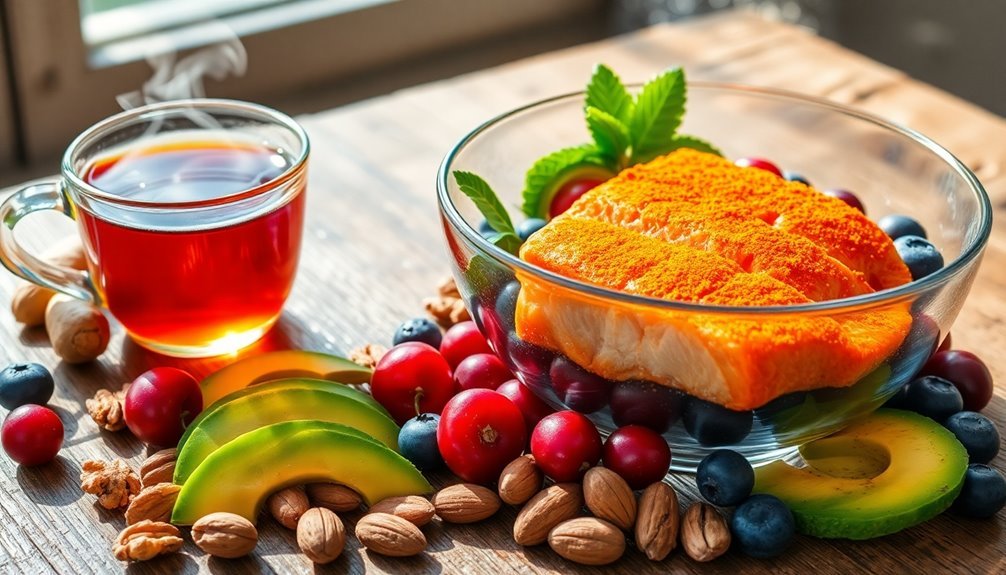You can find immediate joint pain relief with these 7 proven methods. Apply heat therapy for 15-20 minutes using a warm towel or heating pad to boost blood flow. Get moving with gentle exercises like arm circles or walking to maintain flexibility. Try natural anti-inflammatories like turmeric or ginger combined with black pepper. Take a warm bath or try pool exercises to reduce pressure on your joints. Make smart food choices by adding omega-3 rich foods and avoiding processed items. Consider gentle massage or acupressure for targeted relief. Finally, use the RICE method (Rest, Ice, Compression, Elevation) during acute flare-ups. These strategies are just the beginning of your journey to pain-free living.
The Power of Heat Therapy

The application of heat therapy stands as one of the most effective natural remedies for joint pain relief. When you apply heat to your aching joints, it triggers several beneficial responses in your body.
The warmth relaxes your stiff muscles and increases blood flow to the affected area, helping transport essential nutrients that promote healing. For optimal results, apply heat therapy for 15 to 20 minutes when treating joints close to the skin’s surface.
You’ll find several practical ways to harness heat’s therapeutic benefits. Try using an electric heating pad for consistent warmth, or wrap your joint in a warm, damp towel for moist heat therapy. If you prefer full-body relief, a warm shower can help loosen multiple stiff joints simultaneously. For on-the-go relief, heat wraps offer extended comfort throughout your day.
While heat therapy can substantially improve your joint mobility and reduce pain, you’ll need to exercise caution in certain situations. Don’t apply heat if you’re dealing with swollen or bruised joints, open wounds, or conditions like dermatitis or deep vein thrombosis. If you have diabetes, consult your doctor before starting heat therapy.
Research shows that combining heat treatment with exercise can be particularly effective in managing joint pain and improving your overall physical function.
Movement for Joint Freedom
Moving your joints regularly through their full range of motion stands as a cornerstone of effective pain management and long-term joint health. You’ll discover that combining joint distraction techniques with PNF stretching can create lasting mobility improvements.
Through targeted exercises like the A-frame and pigeon pose, you’re able to enhance flexibility in multiple joints while building stability. This approach helps reduce joint compression and prevents damage to important structures like cartilage and meniscus.
Don’t rush your progress – joint mobility requires patience and consistent practice. You’ll want to start with low-impact activities like swimming or walking, gradually increasing intensity as your body adapts.
By incorporating thoracic spine mobilization and arm circles into your daily routine, you’ll help release tension throughout your upper body.
- Feel the freedom as your joints move smoothly without restriction
- Experience the joy of reaching and bending without fear of pain
- Rediscover activities you thought were no longer possible
- Embrace the confidence that comes with improved mobility
- Celebrate each small victory as your range of motion expands
Remember to combine these movements with proper soft tissue therapy and targeted physical therapy exercises for the best results. You’ll find that a well-planned program, focused on specific body areas, creates the most significant long-term improvements.
Natural Anti-Inflammatory Solutions

Nature’s pharmacy offers powerful alternatives to traditional medications for managing joint pain and inflammation. You’ll find remarkable relief through herbs like turmeric, ginger, and Boswellia serrata, which target inflammatory pathways and reduce pain-causing enzymes. These natural powerhouses work by blocking specific compounds that trigger joint discomfort. When combining ginger with black pepper and curcumin, studies show it provides pain relief comparable to naproxen for knee osteoarthritis.
Dietary supplements can amplify your pain-relief strategy. Omega-3 fatty acids from cod liver oil specifically target rheumatoid arthritis pain, while glucosamine sulfate provides relief for osteoarthritis sufferers.
You can also incorporate garlic and berry extracts into your daily routine to combat inflammation at the cellular level.
For immediate relief, try topical solutions containing capsaicin or salicylates. These natural compounds work directly on pain receptors and provide localized comfort.
You’ll also benefit from anti-inflammatory beverages like turmeric-lemon tonic or parsley-ginger green juice, which deliver concentrated doses of healing compounds.
Don’t overlook simple solutions like baking soda water or bone broth, which can calm autoimmune responses and provide essential nutrients.
Water-Based Pain Relief Techniques
While natural remedies offer substantial relief, water-based therapies reveal a powerful dimension of joint pain management. When you immerse yourself in water, its natural properties immediately begin working in your favor.
The water’s buoyancy supports your body weight, reducing stress on your aching joints, while its viscosity provides gentle resistance that strengthens without risking injury. Working with a licensed physical therapist ensures you perform exercises correctly and safely.
You’ll find various water-based techniques particularly effective for managing joint pain. Whether you’re recovering from surgery or dealing with chronic conditions like arthritis or fibromyalgia, pool exercises and hydrotherapy can markedly improve your mobility and reduce inflammation.
The hydrostatic pressure of water enhances your lung and heart function while improving circulation throughout your body.
- Feel the immediate weightlessness as water cradles your painful joints
- Experience the gentle embrace of warm water melting away your muscle tension
- Rediscover the joy of movement without fear of pain
- Gain confidence as your balance and strength improve day by day
- Reclaim your independence through progressive water-based exercises
For the best results, combine water therapy with your existing physical therapy routine, and always consult your healthcare provider about specific exercises suited to your condition.
Smart Dietary Changes

Alongside traditional treatments, making smart dietary choices stands as one of the most powerful ways to combat joint pain. You’ll want to focus on incorporating inflammation-fighting foods into your daily meals, particularly those rich in omega-3 fatty acids like fatty fish, walnuts, and chia seeds. Working with a qualified dietician can help you develop an eating plan tailored to your needs and preferences.
The Mediterranean and DASH diets offer excellent frameworks for joint-healthy eating. These approaches emphasize fruits, vegetables, whole grains, and legumes while limiting inflammatory foods.
You’ll benefit from loading your plate with leafy greens, citrus fruits, and fiber-rich foods that help maintain a healthy weight and reduce strain on your joints.
Be vigilant about avoiding foods that trigger inflammation. Cut back on processed foods, refined carbs, and added sugars. You’ll also want to minimize red meat consumption and eliminate unhealthy trans fats from your diet.
Instead, prioritize nutrient-dense options rich in vitamins D, B6, and calcium. Green tea makes an excellent beverage choice, as its antioxidants help slow cartilage breakdown.
Therapeutic Touch Methods
Beyond dietary changes, therapeutic touch offers powerful relief for joint pain sufferers. Massage therapy stands out as a proven method, increasing circulation and bringing essential nutrients to your aching joints while reducing stress hormones.
You’ll find that regular gentle massage can considerably improve your range of motion and grip strength, especially if you’re dealing with conditions like OA or RA. A 2015 Gallup poll revealed that most Americans trust hands-on therapies for treating pain effectively.
Acupuncture and acupressure have also shown remarkable results in pain management. When combined with traditional treatments, these ancient practices can enhance your relief journey.
Additional options like Healing Touch, Reiki, and TENS therapy provide non-invasive alternatives that may reduce your need for pain medication.
- Feel the warmth of healing hands melting away your discomfort through skilled massage
- Experience the gentle precision of acupuncture needles releasing your body’s natural pain relief
- Let the soothing energy of Healing Touch wash over your aching joints
- Discover the calming influence of acupressure releasing tension from your body
- Embrace the freedom of movement as therapeutic touch restores your joint flexibility
Remember to communicate clearly with your therapist about affected areas, and consider combining these approaches with heat therapy, relaxation techniques, or CBT for the best results.
Rest and Recovery Strategies
Throughout your joint pain journey, proper rest and recovery serve as cornerstones of effective healing. While complete rest allows your body to reduce inflammation and repair damaged tissues, balancing this with active recovery strategies that maintain joint mobility is crucial.
You’ll want to incorporate the RICE method (Rest, Ice, Compression, Elevation) during acute pain phases, applying ice packs to reduce swelling and inflammation. Once the initial inflammation subsides, you can shift to heat therapy or alternate between cold and heat treatments to manage ongoing discomfort effectively.
On your rest days, engage in low-intensity activities like walking or swimming. These gentle exercises help flush out metabolic byproducts while improving circulation and maintaining flexibility. Incorporating aquatic therapy can be particularly beneficial as it reduces impact on your joints while promoting healing.
You don’t want to remain completely inactive, as this can lead to joint stiffness and reduced range of motion.
For long-term success, focus on strengthening exercises and proper nutrition. Stay hydrated and consume foods rich in antioxidants and omega-3 fatty acids.
Consider working with a physical therapist to develop a personalized recovery plan that prevents overtraining and promotes consistent joint health maintenance.
Frequently Asked Questions
Can Joint Supplements Interact With Prescription Medications for Arthritis?
Yes, your joint supplements can interact with arthritis medications. You’ll need to be especially careful with blood thinners, insulin, and antidepressants. Always tell your doctor about supplements you’re taking for safety.
How Long Should I Wait Between Hot and Cold Therapy Applications?
You should wait at least 2 hours between hot and cold therapy sessions. Don’t rush between treatments, as your body needs time to return to its normal temperature for maximum effectiveness.
Are There Specific Weather Conditions That Typically Worsen Joint Pain?
You’ll often experience increased joint pain during cold temperatures, rainy weather, and when barometric pressure drops. High humidity can also worsen your discomfort by causing joint swelling and muscle tightness.
Should I Exercise During an Arthritis Flare-Up?
Yes, you can exercise during flare-ups, but stick to gentle, low-impact activities. Focus on range-of-motion exercises, swimming, or walking. Remember to apply heat before and ice after your workout.
How Do I Choose Between Different Types of Massage for Joint Pain?
Consider your pain tolerance first. Choose Swedish massage for gentle relief, deep tissue for chronic pain, or myofascial release for mild pressure. Always consult your doctor and inform your therapist about your arthritis.
In Summary
You’ve got multiple tools to tackle joint pain right now. Whether you’re applying heat, staying active, choosing anti-inflammatory foods, or practicing smart rest techniques, consistency is key. Remember that you don’t have to live with persistent joint discomfort. Try combining these natural approaches for the best results, and don’t hesitate to adjust them to fit your specific needs and comfort level.




Leave a Reply